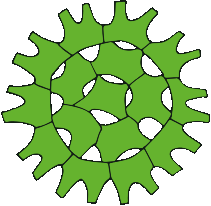Eunotia zasuminensis (Cabejsz.) Körner 1970 is a rather rare diatom species with star-like colonies. It resemlbles the familiar Asterionella and is probably often identified under this name. E. zasuminensis differs from Asterionella in the form of the cells. Where Asterionella formosa particularly has cells where one end is much smaller than the other, in E. zasuminensis both ends are quite the same size. But in the middle there is a little bubble. Actually it looks very much like the humerus, the long bow in one's arm. Of course you have to see the Eunotia cell from the valve face. If y...
Read More
Author: Satu Zwerver
The one with the warts
As a good start for a new plankton year I had the pleasure of meeting Crucigenia mucronata in the Dutch waters. Quite a rare species, but easy to recognize because of the warts. As the name says - mucro (Latin) = point, wart. Size of the cells: 5x7,5 µm.It is mentioned on the Dutch TWN-list, so it must have been seen in the Netherlands earlier. Komárek and Fott (1983) list France, Guadeloupe (who has been there collecting algae!?), India and Iowa in the USA as places where it has been recorded. They also tell us that the species like eutrophic water.In Algaebase we can see that also Spai...
Read More
Planctonema lauterbornii Schmidle 1903
seems to be a species that occurs when the ecosystem is in stress (Leitão et al 2003, Song et la 2009). The Dutch TWN-list has 3 "preferred names" for Planctonema: 2 lauterbornii's and Planctonema subtilissimum. There is Planctonema lauterbornii Schmidle 1903, but then also Pl. lauterbornii sensu M. Watanabe, T. Hori et M. Akiyama 1986. I looked up the article of Watanabe & Co , but - I must say - some of the information did not exactly reach my brain. Maybe it was the Japanese language. So it remains a mystery to me, why Watanabe et al's lauterbornii should be recorded ap...
Read More
Tychonema
Hmm, it's true, then. They are here. Tychonema's. On the Cyanobactria course in Czech Rebublic last August I was quite surprised to hear Prof. Komárek say that Tychonema is quite common in the northern lakes... As he, together with Anagnostidis, wrote in Süsswasserflora 19/2 (2005) they occur "in the plankton of northern, colder lakes, slightly eutrophicated". Found some in a northern lake. Tychonema resembles a lot Planktothrix, and is very closely related too. Both belong to the family Phormidiacea and even to the subfamily Phormidioideae. What is different between these genera is that in T...
Read More
Pediastrum
Found this Pediastrum integrum C.W. Nägeli 1849 in a sample with almost nothing in it. And yes, Komárek and Jankovská (2001) tell that it's common in oligotrophic and dystrophic cold and clear large and small lakes as well as small peaty basins. Everything fine so far. What puzzled me was there also was P. angulosum (C.G. Ehrenberg 1834) ex G.G.A. Meneghini 1840, which Komárek and Jankovská (2001) describe as "rather alkalifilic and does not occur in peaty waters an acidic swamps." But then again, I only saw two coenobia, one of each. In 25 ml. And of course they could occur simultaneu...
Read More
Catalogue of the desmids of Ireland
Wonderful! To be found at AlgaeBase: http://www.algaebase.org/search/bibliography/detail/?biblio_id=47220
Read More
The big one
This big (68x80 µm) Cosmarium botrytis lightened up my day just before lunch break. It was cathed in a lake Kurtinjärvi in Kuusamo, in the north of Finland. West & West (1912) already mention, that it has been seen in Finland. A quite a common species, found all over. West & West describe 7 varieties of this species with "considerable amount of variability": paxillosporum, subtumidum, tumidum, gemmiferum, emarginatum, mediolaeve and depressum. They only mention var. gemmiferum as seen in Finland at that time. Skuja mentions the species in some northern lakes in Sweden in 1948, with 3 ...
Read More
They still love Zooplankton!
In the newest Hydrobiologia (Volume 676, Number 1 / November 2011) there is a bunch of articles about zooplankton. Wonderful! "Cladocera crustaceans: sentinels of environmental change" Eggermont & Martens write in the preface. I do believe they are. Jeppesen et al plead for including zooplankton to the European Water Framework Directive. No objections heard from me. What makes me especially happy is the high number of Finnishs names as authors.
Read More
Public alien observations
Finland’s environmental administration asks people to inform the authorities about their observations on alien species. In the Baltic Sea, that is. With more information on the species the authorities can plan the steps needed to be taken, if there are any. To make it as easy as possible, there is even a form on the net one can fill in in case of an alien observation. As far as I could find out, the form was only in Finnish. There are quite a few Swedish speaking citizens living on the coast, with a large knowlegde of the sea and it's life. I hope they find their way to the form too. Further ...
Read More
Getting ready for the Baltic Sea
Visited Mrs. Terttu Finni in Helsinki yesterday. We had a fine day looking at the samples from the coastal waters of the brackish Baltic Sea with her the microscope. Went through the most common species and dicussed almost 50 taxa. I kind of like Chaetoceros-species. The first step towards counting Baltic Sea phytoplankton is taken.
Read More
